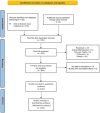Current application status of non-invasive brain stimulation techniques in Alzheimer's disease: a bibliometric analysis
- PMID: 41079992
- PMCID: PMC12507917
- DOI: 10.3389/fnagi.2025.1585885
Current application status of non-invasive brain stimulation techniques in Alzheimer's disease: a bibliometric analysis
Abstract
Objective: Alzheimer's disease (AD) poses a significant global public health challenge. Non-invasive brain stimulation (NIBS) has emerged as a promising therapeutic strategy and constitutes a rapidly evolving research domain for AD intervention. This study aims to synthesize recent advancements in NIBS technologies for AD through comprehensive knowledge mapping. By mapping the research landscape, identifying key trends, and analyzing collaborative networks, we seek to explore emerging frontiers and translational potential of NIBS in AD research, thereby informing evidence-based clinical practice.
Methods: Using the Science Citation Index Expanded (SCI-E) of Web of Science Core Collection (WOSCC) database. The analysis included an evaluation of publication trends, journal distribution statistics, country/region and institutional collaboration networks, author and co-cited author networks, co-citation document networks, as well as keywords and research hotspot analysis. Then CiteSpace, GraphPad Prism, VOSviewer, Microsoft Excel and NoteExpress were used for follow-up bibliometric analysis.
Results: A total of 632 studies were included in this study. Research on NIBS applications in AD peaked during 2020-2021. The predominant journals disseminating NIBS-AD research were Journal of Alzheimer's Disease, Frontiers in Aging Neuroscience, and Clinical Neurophysiology. Italy, China, and the United States led in research contributions during this period. At the institutional level, Harvard Medical School and the University of Brescia published the most. There are 529 authors in this field, among which Professor Giacomo Koch maintains a continuous academic leadership position. Keyword analysis revealed high-frequency terms, "Alzheimer's disease," "transcranial magnetic stimulation," and "mild cognitive impairment." "Impairment" and "non-invasive brain stimulation" emerged as citation burst terms from 2022 onward, signaling current investigative priorities centered on NIBS-induced cognitive modulation, therapeutic target selection, and underlying neurophysiological mechanisms.
Conclusion: This study comprehensively reviews current research status, hotspots and trends of NIBS in AD. The results suggest that researchers should focus on the cognitive impact of NIBS technology on AD patients, the best therapeutic targets and potential mechanisms. Strengthening global collaboration among international, institutional and scientific researchers should be promoted to promote the in-depth development of this field.
Keywords: Alzheimer’s disease; CiteSpace; bibliometric analysis; non-invasive brain stimulation; transcranial magnetic stimulation.
Copyright © 2025 Cong, Wang, Yan, Sun, Zheng, Xie, Yu and Qian.
Conflict of interest statement
The authors declare that the research was conducted in the absence of any commercial or financial relationships that could be construed as a potential conflict of interest.
Figures














